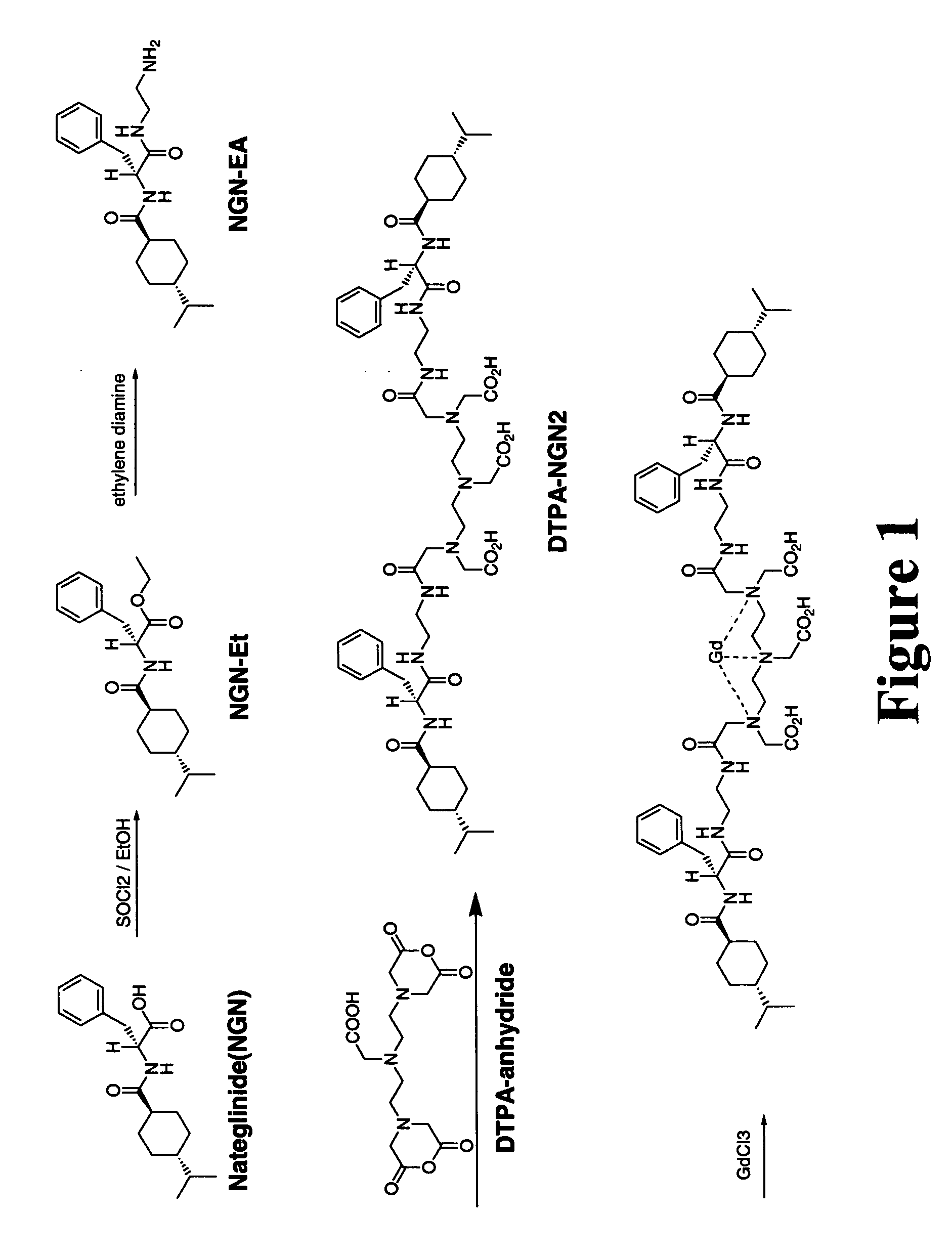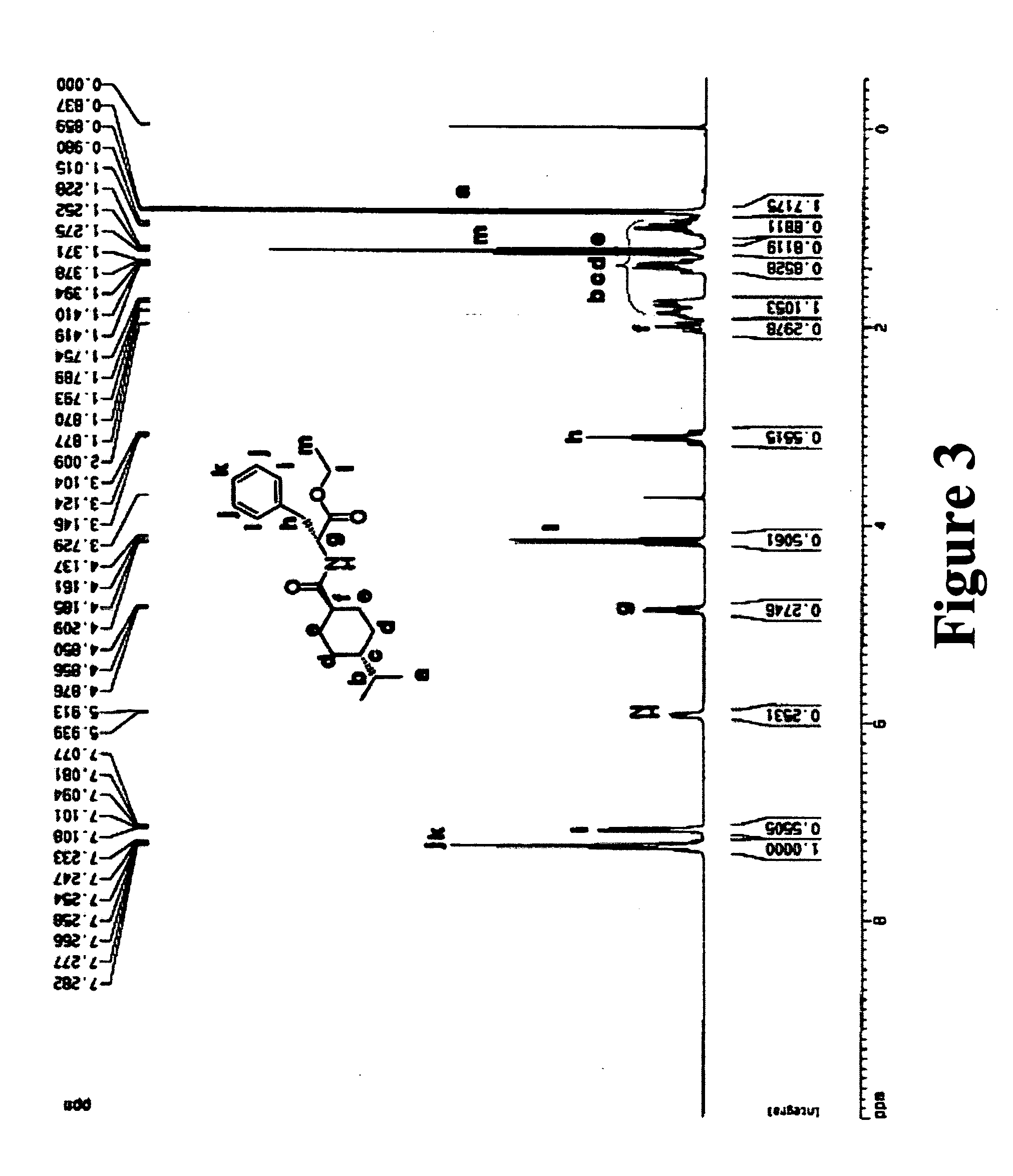Mechanism-based targeted pancreatic beta cell imaging and therapy
a technology of pancreatic beta cells and imaging and therapy, applied in the field of mechano-based targeted pancreatic beta cell imaging and therapy, can solve the problems of biliary obstruction, increased risk of pancreatic cancer, and relatively undefined appropriate mitogenic signaling pathways of beta cells
- Summary
- Abstract
- Description
- Claims
- Application Information
AI Technical Summary
Benefits of technology
Problems solved by technology
Method used
Image
Examples
example 1
Synthesis of DTPA-Nateglinide (DTPA-NGN)
[0076] DTPA-nateglinide was synthesized in a two-step manner. The synthetic scheme is shown in FIG. 1.
Step 1. Synthesis of Aminoethyl Amide Analogue of Nateglinide
[0077] Nateglinide (3.1742 g, 10 mmol) was dissolved in 20 mL of ethyl alcohol. Thionyl Chloride (5.1 mL, 70 mmol) was added dropwise to the solution. The reaction mixture was stirred overnight and the solvent was evaporated at reduced pressure. FIGS. 2 and 3 showed 1H-NMR of nateglinide and its ester form.
[0078] Ethyl alcohol (20 mL) and ethylene diamine (3.4 mL, 50 mmol) were added. The mixture was stirred overnight. The solvent was evaporated at reduced pressure. The solid was dissolved in chloroform (50 mL) and washed with water (2×50 mL). The chloroform layer was dried over anhydrous magnesium sulfate. The solvent was filtered and evaporated at reduced pressure. Aminoethyl amide analogue of nateglinide was obtained as a white solid (3.559 g, 99% yield). FIGS. 4 and 5 showe...
example 2
Synthesis of DTPA-Glipizide (DTPA-GLP)
[0080] Glipizide (445.5 mg, 1.0 mmol) was dissolved in DMSO (anhydrous, 10 ml). Sodium amide (76.03 mg, 2.0 mmol) was then added. The reaction mixture was stirred at room temperature for 10 min. DTPA-dianhydride (357.32 mg, 1.0 mmol) was dissolved in DMSO (anhydrous, 10 ml). Sodium amide (76.03 mg, 2.0 mmol) was then added. The reaction mixture was stirred at room temperature for 10 min. DTPA-dianhydride (357.32 mg, 1.0 mmol) dissolved in 5 ml DMSO (anhydrous) was added and the mixture was stirred for 4 hours. The mixture was added with water (10 mL), followed by 1N-sodium hydroxide solution (3 mL) and stirred for 2 hours. The solid was filtered and washed with water. This recovered starting material was 142.6 mg (32%) after drying under vacuum. The aqueous phase was dialyzed with membrane (MW CO1H-, 13C-NMR spectrum and assignment and mass spectrometry of DTPA-glipizide.
example 3
Synthesis of DTPA-Glyburide (DTPA-GLB)
[0081] Glyburide (494.0 mg, 1.0 mmol) was dissolved in DMSO (anhydrous, 5 ml). Sodium amide (195.0 mg, 5.0 mmol) was then added. The reaction mixture was stirred at room temperature for 10 min. DTPA-dianhydride (357.32 mg, 1.0 mmol) dissolved in 5 ml DMSO (anhydrous) was added and the mixture was stirred for 22 hours. The dark green colored mixture was added with water (10 mL), followed by 1N-sodium hydroxide solution (5 mL) and stirred for 2 hours. The solid was filtered and washed with water. This recovered starting material was 88.9 mg (18%) after drying under vacuum. The aqueous phase was dialyzed with membrane (MW CO1H-, 13C-NMR spectrum and assignment of glyburide and DTPA-glyburide.
PUM
| Property | Measurement | Unit |
|---|---|---|
| composition | aaaaa | aaaaa |
| PET | aaaaa | aaaaa |
| MRI | aaaaa | aaaaa |
Abstract
Description
Claims
Application Information
 Login to View More
Login to View More - R&D
- Intellectual Property
- Life Sciences
- Materials
- Tech Scout
- Unparalleled Data Quality
- Higher Quality Content
- 60% Fewer Hallucinations
Browse by: Latest US Patents, China's latest patents, Technical Efficacy Thesaurus, Application Domain, Technology Topic, Popular Technical Reports.
© 2025 PatSnap. All rights reserved.Legal|Privacy policy|Modern Slavery Act Transparency Statement|Sitemap|About US| Contact US: help@patsnap.com



